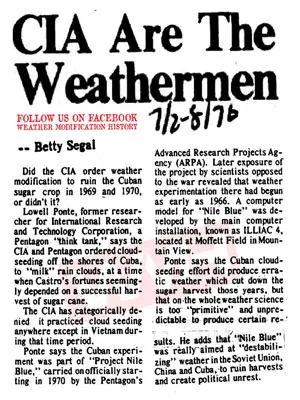Streamed live on Facebook: https://www.facebook.com/about/videos/1185363314944294/
Help me replace my video card! (It’s my birthday!)
https://www.paypal.me/climateviewer
ClimateViewer Pollution Tracker Map - Mapping Climate Change Today!
https://climateviewer.com/pollution/
Black Blizzard - Dust Bowl
https://www.history.com/topics/dust-bowl
VIDEO: https://www.history.com/topics/dust-bowl/videos/black-blizzard
The Dust Bowl was the name given to the drought-stricken Southern Plains region of the United States, which suffered severe dust storms during a dry period in the 1930s. As high winds and choking dust swept the region from Texas to Nebraska, people and livestock were killed and crops failed across the entire region. The Dust Bowl intensified the crushing economic impacts of the Great Depression and drove many farming families on a desperate migration in search of work and better living conditions.
Great Plains Shelterbelt: Fixing the Dust Bowl (Climate Change 1.0)
https://en.wikipedia.org/wiki/Great_Plains_Shelterbelt
The Great Plains Shelterbelt was a project to create windbreaks in the Great Plains states of the United States, that began in 1934. President Franklin D. Roosevelt initiated the project in response to the severe dust storms of the Dust Bowl, which resulted in significant soil erosion and drought. The United States Forest Service believed that planting trees on the perimeters of farms would reduce wind velocity and lessen evaporation of moisture from the soil. By 1942, 220 million trees had been planted, stretching out 18,600 miles (29,900 km) in a 100-mile-wide zone from Canada to the Brazos River. Even as of 2007, “the federal response to the Dust Bowl, including the PSFP [Prairie States Forestry Program which planted the Great Plains Shelterbelt and creation of the Soil Erosion Service, represents the largest and most-focused effort of the [U.S.] government to address an environmental problem.”
In Nebraska, historic shelterbelts are making way for more crops
https://www.marketplace.org/2017/11/28/sustainability/cutting-down-great-plains-shelterbelt
Can Doctor Evil Save the World? A Geoengineering Tale
SRM geoengineering: how to deal with the losers?
https://groups.google.com/d/msg/geoengineering/ipdLpbnXHeU/tAXDtadrNR0J
Geo-engineering: Climate fixes ‘could harm billions’
http://www.bbc.com/news/science-environment-30197085
‘Accidental Geoengineering’ with Ship Tracks and Contrails
https://climateviewer.com/2018/04/01/accidental-geoengineering-with-ship-tracks-contrails/
How Monsanto and Weather Modification Are Really Related!
https://climateviewer.com/2018/02/17/how-monsanto-and-weather-modification-are-really-related/
As climate risks rise, scientists call for rules on solar engineering
http://news.trust.org/item/20181001160020-i0twm/
Hands Off Mother Earth Manifesto: A Permanent Ban on Geoengineering
AGAINST GEOENGINEERING
http://www.geoengineeringmonitor.org/2018/11/against-geoengineering/
Stopping Solar Geoengineering Through Technical Means: A Preliminary Assessment of Counter‐Geoengineering
https://agupubs.onlinelibrary.wiley.com/doi/full/10.1029/2018EF000864
Fake plastic trees and a volcanic push to keep the globe cool
David Keith’s Carbon Sequestration Business: Carbon Engineering
Scientists champion forests as ‘unsung hero’ of climate action
Forest Conservation Is Part of the Climate Conversation Too
https://www.sierraclub.org/sierra/forest-conservation-part-climate-conversation-too
While the logging industry in the South claims that wood pellets are primarily produced using limbs, sawdust, and other forestry byproducts, Smith says that Dogwood and other environmental groups have documented logging operations taking down whole forests to produce the pellets—meaning Europe’s quest for clean energy could be exacerbating the destruction of American forestland. Europe recently reauthorized the use of wood biomass as a renewable to reach its 2030 clean energy goals despite the objections of 800 scientists and a study suggesting biomass use would bump Europe’s emissions up by 10 to 15 percent by 2050. In the United States, members of Congress and the EPA have been pushing to redefine biomass as carbon-neutral as well, meaning southern forests could face even more pressure if biomass catches on here.
Europe’s policy to treat wood as low-carbon fuel poised to harm global forests
Seeing the Forest: Nature’s Solution To Climate Change
https://stand4forests.org/wp-content/uploads/2018/09/The-Climate-Plan.pdf
Regreening the planet could cut as much carbon as halting oil use – report
The Best Technology for Fighting Climate Change? Trees
Seeing the forest for the trees: World’s largest reforestation program overlooks wildlife
https://www.sciencedaily.com/releases/2016/09/160907125303.htm
Owner Finances Thousands Of Acres To Off-Gridders And Wilderness Lovers!
https://www.offgridquest.com/rural-land/Acres-and-acres
GEOENGINEERING PRESENTATIONS
Geoengineering, Weather Modification, and Weaponizing Nature
CV News ● Scribd ● Google Slides ● PDF with Slide Notes ● Slide Notes on Scribd




























